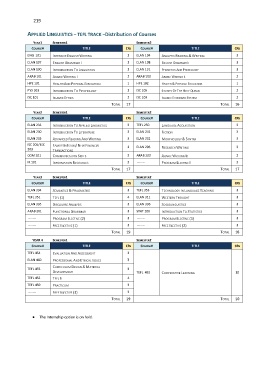Page 220 - University Bulletin
P. 220
FIN315 Financial Statement Analysis and Reporting
Credits: 3 (3, 0, 0) Prerequisites: FIN210, ACC111
This course aims to provide students with a comprehensive framework for analyzing and
forecasting financial statements to evaluate the performance of companies. Topics include
financial ratios, market multiples, the effect of different accounting methods on financial analysis,
financial reporting quality, and forecasting financial statements.
FIN320 Principles of Investment
Credits: 3 (3, 0, 0) Prerequisites: FIN210, FIN250
This is an intermediate course in finance that, first, presents financial markets’ role, functioning
and instruments (traditional and derivatives). Second, the central question of price formation is
addressed: are securities fairly priced. The answer to that question determines the strategies used
by investors. There are two cases: If investors believe that prices are fair, they will play passive
strategies. Whereas when investors believe that the pricing process is not fair, they will try to
catch up with investment opportunities by executing active investment strategies. Distinguish
between open and closed end funds; exchange traded funds and other types of professionally
managed investment companies and discuss the various types of fund loads, fees and charges.
Finally, the efficient market hypothesis is presented in terms of issues, anomalies and implications.
FIN321 International Finance
Credits: 3 (3, 0, 0) Prerequisites: FIN310
The course is designed to provide a rigorous understanding of the International Financial
Mechanism, Measuring Exposure to Exchange Rate Fluctuations, Direct Foreign Investment,
Multinational Capital Budgeting, International Corporate Governance and Control, Country Risk
Analysis, Multinational Capital Structure and Cost of Capital and International Cash Management.
The course also focuses on the role of a financial manager from an international perspective. The
risk to the firm, due to exchange rate fluctuations, is divided into Economic, transaction, and
translation exposure. For each of these areas, an attempt is made to answer questions like: why
and how do fluctuating exchange rates place the multinational firm at risk? What can the firm do
to minimize the risk associated with fluctuating exchange rates? International sources of financing
international trade along with issues relating to the way a firm raises capital are also considered.
In this regard, the analysis of foreign capital markets and Euro markets is undertaken.
International financial institutions and their role in the economic development of several countries
will also be analyzed.
FIN335 Financial Data Analysis
Credits: 3 (3, 0, 0) Prerequisites: STAT271, FIN310
This course provides basic knowledge about the main econometric techniques applicable to
financial data analysis. Econometrics can be defined as the application of mathematical and
statistical methods to the analysis of economic and financial data. This course introduces basic
econometric modelling techniques such as classical linear regression, univariate time series,
cointegration, volatility forecasting, and panel data. These techniques will allow the student to
analyze finance related problems empirically. At the end of this course, students should feel
comfortable applying basic econometrics tools to analyze simple financial theoretical models
empirically.
208 PSU UNDERGRADUATE BULLETIN

